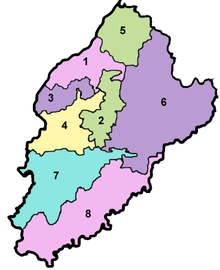Samundri Tehsil
| Samundri Tehsil تحصیل سمندری | |
|---|---|
| Tehsil | |
| Country | Pakistan |
| Region | Punjab |
| District | Faisalabad District |
| Capital | Samundri |
| Towns | 1 |
| Union councils | ? |
| Time zone | PST (UTC+5) |
| • Summer (DST) | PDT (UTC+6) |
Samundri Tehsil (Urdu, Punjabi: تحصیل سمندری) is an administrative subdivision, tehsil, of Faisalabad District in Punjab province of Pakistan. The lands of the Tehsil Samundri are irrigated by Gogera branch canal and Burala branch canal. All villages of the tehsil carry G.B. with their Chak numbers and name of village usually follows it for example CHAK No.48GB Maluwaal. Sugar cane is the major cash crop of the area. Wheat, cotton and vegetables are also grown in the fertile lands of the tehsil.
History
The name of Samundri comes from the presence of three (Seh=three)Hindu temples (Mandr=temple). Hence called Seh-Mandri means a small city with three temples.The name later weired and was converted to Samundri. The city still has lots of old buildings constructed in 1930's or before. Until 1904, during British rule, Samundri was headquarters of a tehsil in the district of Jhang. With the creation of Lyallpur District the Samudri Tehsil was transferred to this district. At that time having an area of 1,309 square miles (3,390 km2).,[1] and it was reduced to 222,005 acres (898.42 km2) as a result of its bifurcation in 1994.
The population in 1906 was 266,277, at that time it contains 495 villages, including Samundri (population, 765), the headquarters. The land revenue and cesses in 1905-6 amounted to 6-7 lakhs. The tehsil consists of a level plain sloping gently towards the Ravi and the Deg on the south, and is now wholly irrigated by the Chenab Canal, except for a few scattered plots in the Ravi lowlands which still depend on wells. The soil generally is a fine loam. The boundaries of the tahsil were somewhat modified at the time of the formation of the new District.[1]
The total area of the Tehsil was 4,99,462 Acres which was reduced to 2,22,005 Acres as a result of its bifurcation in 1994, giving birth to new Tehsil named Tandlianwala.
Ethnic makeup
Religions: Islam is dominant religion (99%)while Christians, Chumars, Qadianies make rest of 1%. Caste system, adopted from Hinduism is also practiced as most of the population are migrants from India. Main castes in Tehsil Samundri are Jat, Arain, Gujjar and Rajput while Butts, Muhgals, Ansaries, Shaikhs and Quraishies are minor ones.There are 136 villages in Tehsil Samundri.
Problems
Being agriculture dependent area (almost no/negligible industry), there is extreme shortage of canal water and it is the major reason for poor economic conditions of the farmers here as it is purely irrigated land (rainfall is very rare or uneven during the year). Lack of good quality drinking water is the cause of poor health of the inhabitants.
Facilities
Hospitals: about ten public and private hospitals but good child specialists and cardiologists are not available.
Education: There are many colleges and schools in the area that is why the education level is growing in this area.
Communication: Internet, mobile phone service, fixed line phones are available and are of very good quality.
Roads: Paved roads connecting rural areas to the city. Samundri is also connected to Faisalabad, Gojra, Okara and Rajana with excellent quality roads. There are two major highways which connect Faisalabad to Multan, Rahim Yar Khan, etc. They are Samundri Road and Jhang road. Samundri city east part comprises those villages, whose most population is in gulf states, and the its western parts peoples are in europe. The people of samundri city are very civilized, they are considered to be the rich people at an average in Pakistan. Qudrat Ullah Shahab in his famous novel Shahab Nama wrote about his mother who lived in Chk No 507GB. Which was then in Samundri tehsil.
References
| ||||||||||||||||||||||||
| |||||||||||||||||||||||||||||||||||||||||||||||||||||||||||||||||||
